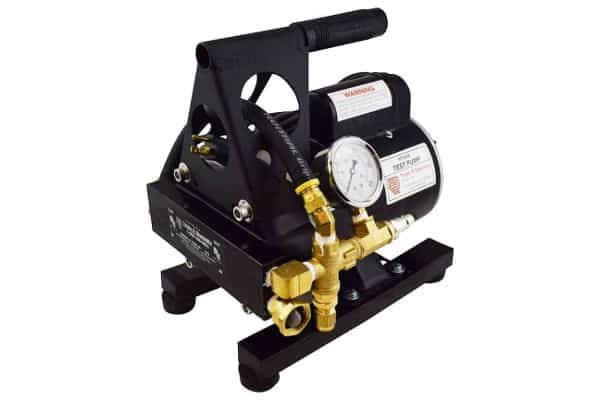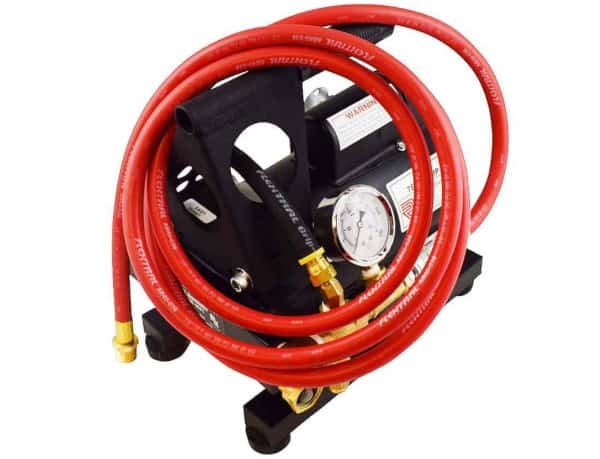Learn the key hydrostatic test pump components and considerations
As the force behind hydrostatic testing, hydrostatic test pumps deliver peace of mind that water-based fire protection systems won’t leak during use. They ensure that piping set-ups will perform under pressure during a fire.
In previous blogs, we’ve dug into requirements for performing hydrostatic tests and explored:
- Choosing a Hydrostatic Test Pump for Sprinklers and Standpipes
- Hydrostatic Test Pump Features to Consider When Selecting a Pump
- How to Use and Troubleshoot a Hydrostatic Test Pump
This time, we’re getting back to basics: explaining what a hydrostatic test pump is, its important parts, and how it works.
If you’re shopping for a hydrostatic test pump, feel free to skip directly to our selection of Triple R pumps. QRFS carries the lightweight and versatile Tru-Test models (250 psi/2.2 GPM) and more powerful HT-454 (400 psi/3.0 GPM), HT90E, and HT89A models (both at 300 psi/3.0 GPM).
When hydrostatic testing of fire protection systems is needed
A qualified fire protection ITM professional uses a hydrostatic test pump to force water into a fire protection system at high pressure. The test offers reassurance that piping was assembled correctly, that damage or corrosion hasn’t caused weaknesses to develop, and, in the case of systems that have them, that the Fire Department Connection (FDC – also referred to as the Siamese Connection) can withstand high pressures.
Testing occurs at the lowest access point in the system. Inspectors visually examine the pipes, joints, and fittings for leaks and monitor gauges to ensure readings stay within 5 PSI (pounds per square inch) of the specified test pressure. Sometimes, significant drops only indicate a faulty gauge or a faulty pump—but they can also reveal a potentially serious problem with system integrity.
The National Fire Protection Agency (NFPA) requires hydrostatic testing of commercial fire sprinkler systems when they’re first installed and whenever system modifications involve more than 20 sprinkler heads. This “acceptance testing” must be conducted at a minimum of 200 psi for two hours in both wet and dry sprinkler systems. Small, subsequent modifications can be retested at normal working pressure, but larger revisions must be isolated and proven to tolerate high pressures.
For residential sprinkler systems, hydrostatic testing is only required at working pressure when the system is installed, according to NFPA 13D: Standard for the Installation of Sprinkler Systems in One- and Two-Family Dwellings and Manufactured Homes. There’s one exception: if the system has a fire department pumper connection, it must follow the guidelines for commercial systems.
Testing requirements for standpipe systems are perhaps the strictest. All standpipes must be tested prior to system acceptance. Certain systems must also undergo full hydrostatic tests every five years, including manual wet standpipes not part of a combined sprinkler/standpipe system, manual dry standpipes, and semi-automatic dry standpipes.
For a deeper look at when, where, and how hydrostatic testing is required, read our previous blog: “What is Hydrostatic Testing of a Building’s Fire Protection System?”
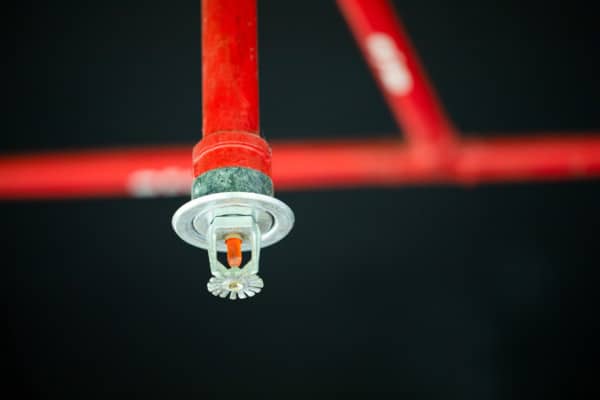
The technology behind the test: hydrostatic test pumps
Hydrostatic test pumps can be used to pressure test various water systems in residential and commercial buildings, from sprinklers to plumbing lines. Core features are shared by all test pumps, but power, durability, portability, and control can vary greatly among models.
Most standard hydrostatic test pumps are electric. Although they generate less speed and horsepower than larger gas-powered pumps, they produce plenty for most life safety applications. Many inspectors prefer the convenience of plugging in an electric pump instead of messing with fuel. Electric pumps also eliminate concerns about fumes if used indoors or in other enclosed settings.
Triple R’s small-but-powerful Tru-Test pump can even be purchased with power hook-ups that can run off of a car battery, making it possible to use electric pumps in unfinished buildings without working power.
Larger, more powerful, gas-powered pumps pressurize systems faster and fill them with water more quickly than electric pumps. They are typically reserved for bigger jobs with bigger pipe, such as a standpipe test in a very tall building.
When selecting a pump specially designed for fire protection systems, the basic criteria boils down to this: how much pump you need in terms of the maximum pressure in PSI and volume in gallons per minute (GPM)—and the pump’s power source, which can be gas, electric, drill-powered, or a hand pump. Essentially, any pump that can maintain 200 psi (or 50 psi higher than a maximum working pressure that exceeds 150 psi) can adequately perform a hydrostatic test.
But while pressure shouldn’t be discounted, zeroing in on the right GPM can save time and money by determining how long tests will take. The higher the GPM, the faster the system can fill and/or pressurize. Triple R Specialty explains that a pump rated for 2.0 GPM at a max pressure of 500 psi will take twice as long to complete a test as a pump rated for 4.5 GPM at a max pressure of 400 psi.
Test pumps powered by hand or drill tend to have GPMs of less than 2.0, making them a less common choice for hydrostatic testing. Many contractors also avoid the inconvenience of needing to hand pump or squeeze a drill’s trigger … and having to wait longer.
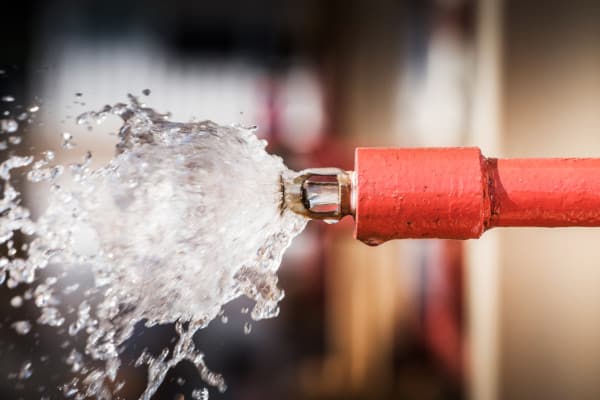
Other important criteria that factor into which pump inspectors should use include:
- Diameter and length of the pipe being tested. A small, residential sprinkler system won’t take nearly as long to achieve test pressure as a big standpipe system.
- The type of system and the natural pressure of its water source. It goes without saying that it’s going to take longer to fill and pressurize a manual dry standpipe vs. a manual wet standpipe. Similarly, a modified wet sprinkler system that’s fed by a city water supply may only naturally generate about 50 to 80 psi of pressure.
- The building’s size and height. NFPA knew what it was doing when it specified running the test at a low point in the system but also checking test pressures at system high points. Gravity on Earth is a constant, after all.
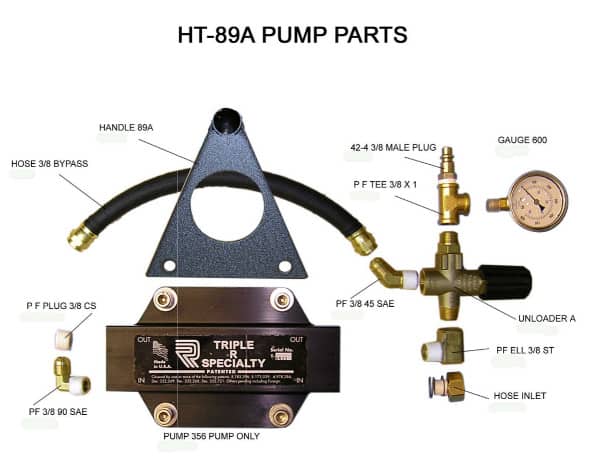
The main components of hydrostatic test pumps
The pump
Most hydrostatic test pumps rely on piston- or plunger-type pumps that work best with pressurized water supplies. In order to use them with a non-pressurized water source, starting a gravity feed—essentially, using gravity as the pressure source needed to flow water into the pump—is typically enough to create positive flow. Simply place the pump at a lower elevation than the container holding the supply of water, turn it on with the priming valve open, and let gravity do its work.
In newer models, the pump is often attached directly to the face of the motor—eliminating the shaft common in older machines. This improvement leads to fewer moving parts, less maintenance, and lower overall weight.
The power source
Hydrostatic test pump motors generally rely on three main power sources: battery power, plug-in electric, and gas. Motor size, or horsepower, is determined by the amount of pressure and volume required.
Here’s a word to the wise: For plug-in electric and battery-powered pumps, don’t forget to check whether the power source meets the motor’s electrical requirements. That includes any voltage, phase, hertz, and amperage requirements noted by the manufacturer. It’s also important to check whether the pump’s parts have enough oil and any other needed fluids before testing begins, including the engine crankcase, gear reduction, and gas tanks.
Bypass/pressure regulator
Fire protection systems—especially small ones—can pressurize very quickly. To avoid damage, some pumps, such as Triple R’s HT-89A, include pressure regulators that keep pressure in check without minute-by-minute monitoring.
Regulators can be preset to close off the water supply after detecting that the outlet pressure has hit a specific number. A full-flow bypass then diverts water directed at the outlet hose back into the pump itself.
But while pressure regulators are a useful fail-safe that enables contractors to focus on more important tasks than continuously monitoring system pressure, it’s still wise to check in on the pump. Friction from recirculation causes water to become increasingly hot, which can damage the pump if the regulator runs for too long. What counts as too long can vary from a few minutes to an hour, so be sure to check your manufacturer’s recommendations before performing a test.
On a related note, hydrostatic test pumps generally employ two methods of maintaining system pressure after the supply line or outlet hose is disconnected. Some pumps close off the pressure using a manually operated valve that’s situated at the supply line. Others rely on an in-line check valve that activates automatically when water flows in the wrong direction, as happens when a pump shuts off.
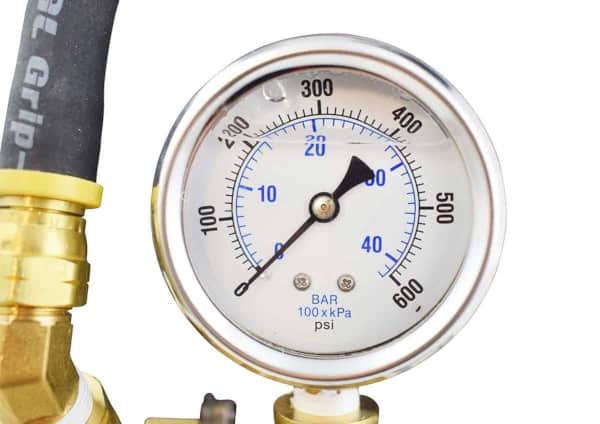
The gauge
Hydrostatic test pumps include a gauge that indicates the pressure supplied to the system. Read this carefully: that’s different from system pressure, which is measured by a separate gauge.
A test pump’s gauge must be capable of reading up to two times the maximum pump pressure. Put simply, if the pump is rated for 300 psi, the gauge must be able to read at least 600 psi. Generally, the middle of the scale on the gauge offers the most accurate readings.
Vibration is the leading cause of gauge failure. Just like any other pump, moving components on hydrostatic test pumps pulse, vibrate, and generate heat when used as intended. Over time, these forces can damage a gauge’s sensitive parts like links and pivots. Eventually, permanent damage and inaccurate readings can result.
The best hydrostatic pumps rely on a gauge filled with a liquid such as silicone or glycerin that help stabilize its needle. Liquid-filled gauges also limit the build-up of condensation, lubricate moving parts, and guard against sudden changes in temperature.
Watch this video to understand the damage vibration can wreak on a gauge’s internal components:
Of course, liquid-filled gauges do present some downsides. Dry models don’t suffer leaks and never need to be refilled. They can also operate at temperatures as low as -40°F – although the -4°F temperatures permitted by most liquid-filled gauges are adequate for hydrostatic test pump applications.
Pump hoses and electrical cords
Test pumps come equipped with electrical cords and hoses that provide the flexibility needed to connect to a fire protection system during testing. Long lengths of cable—like the 25 feet included with Triple R’s 12-Volt Tru-Test—stretch over long distances, making it easier to connect to a battery in a parked vehicle. Other electric pumps come with shorter lengths of cord—most often, six feet—that can be combined with standard extension cords if needed.
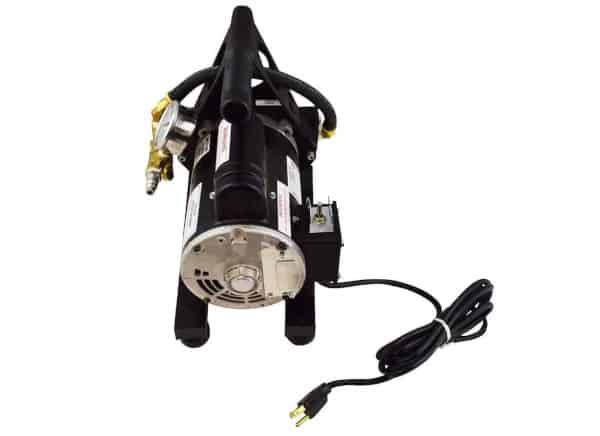
Hydrostatic test pumps rely on outlet and inlet hoses to move water from the supply source to the system that’s being tested. Outlet hoses, designed to withstand high pressures, connect pumps to the fire sprinkler or standpipe system.
Inlet, or supply, hoses, usually use basic garden-hose connections to connect the water source to the pump. Longer lengths of supply hose may collapse during suction, so a sturdy, short hose will offer better performance than a full-length garden hose. To minimize the risk of pump damage or clog-induced flooding, supply hoses also typically feed into a suction-side strainer that blocks debris from the water supply.
Different manufacturers supply different hose lengths with their pumps. Reed’s electric hydrostatic test pumps include 15 feet of outlet hose, for instance, while Triple R supplies 10 feet of quick-disconnect outlet hose with all models and 5 feet of supply hose with the HT-454 and Tru-Test pumps.
Quick-disconnect couplings feature a one-way valve that allows the hose to easily separate from the pump, making it easy for fire protection professionals to verify that the piping can maintain pressure on its own. But with this advantage comes a minor flaw: the threaded end that connects to the system is smaller than the 2.5-inch NPT-threaded swivel found on most FDCs, where many systems are tested. When those couplings are used, additional reducers or adapters will be needed.
Pump materials
Weight plays a major role in choosing a hydrostatic test pump, impacting how easy it is for contractors to move around job sites. Generally, the more powerful the machine, the more it weighs. Large-dimension pumps may require two people to carry them and are often mounted on wheels.
Even so, the material used to mold pump parts can create major differences in weight and size between otherwise comparable machines. Pumps rated between 220 psi and 500 psi generally provide enough pressure for fire sprinkler and standpipe testing applications, but the most portable pumps deliver that power at a weight that falls below 40 pounds.
The lightest pumps incorporate aluminum components that weigh dramatically less than parts made from other metals. A cubic foot of aluminum is roughly three times lighter than the same volume of copper, iron, or steel.
For instance, Triple R’s kit-style Tru-Test pumps weigh only 22 pounds—including its protective metal case. Such easy portability packs the power of 250 psi and 2.2 GPM.
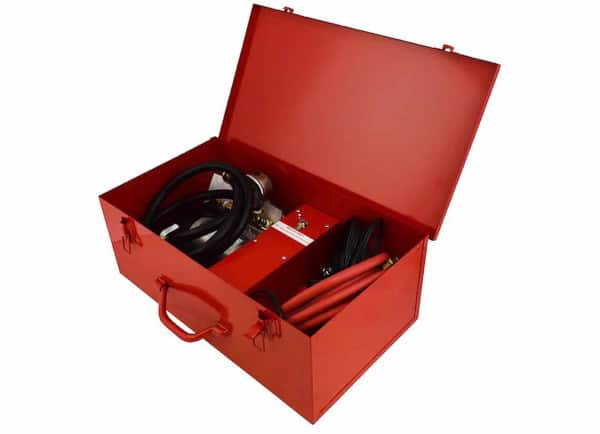
Aluminum construction also places the manufacturer’s more powerful electric models among the lightest choices in their PSI/GPM class, with the HT-90E weighing in at 32 pounds (300 psi/3.0 GPM), the HT-454 weighing 34 pounds (400 psi/3.0 GPM), and the HT-89A weighing 35 pounds (300 psi/3.0 GPM).
By comparison, hydrostatic test pumps by other manufacturers typically weigh more, from Reed’s EHTP500 (37.5 pounds and 500 psi/2.0 GPM) to Rice’s EL1A (74 pounds and 500 psi/3.0 GPM), although that one also includes a roll cage.
Of course, lighter weight isn’t the only advantage of using aluminum parts. Aluminum-based pumps are also more resistant to damage from corrosion and freezing. Casings on older models crafted from cast iron or other metals have been known to crack when vibrating in freezing temperatures.
Brass piping can also help keep weight down and corrosion resistance up in hydrostatic test pumps, compared to traditional cast iron or galvanized steel options.
How do all these parts work together?
Basically, all hydrostatic test pumps work the same: pumping water into a piping system at higher-than-normal pressure to ensure the system is drip-free and there’s minimal risk of failure. Note that the following steps only represent best practices, and manufacturer’s instructions should be followed for specific pumps.
To start the test, inspectors must first make sure all lines are filled with water and any air is removed. Opening the inspector’s test valve – or another valve on the end opposite the water input – will allow air to escape.
Connect the test hose to the system, and then to the hydrostatic test pump. Turn on the water to the pump, and then turn on the pump. Alternately watch the gauge and the pipes, checking for visible leaks and monitoring system pressure. After the desired pressure is reached, turn off the pump and disconnect the test hose.
For step-by-step instructions, check out our previous blog on using hydrostatic test pumps.
Hydrostatic test pumps ensure the integrity of fire protection systems
Hydrostatic test pumps make it possible for fire safety inspectors to test the integrity of water-based fire protection systems. They help identify problems that can be easily missed during a visual inspection, delivering assurance to property owners and fire safety officials that a system will perform as intended during a fire.
If you’re shopping for a hydrostatic test pump, be sure to browse our selection. QRFS carries the best pumps in the business, including lightweight and versatile Tru-Test models (250 psi/2.2 GPM) and more powerful HT-454 (400 psi/3.0 GPM), HT90E, and HT89A models (both at 300 psi/3.0 GPM).
For any other Triple R Specialty pump you may be interested in, or to find out more information about pumps or hydrostatic testing, give us a call at 888.392.3362 or email support@qrfs.com.
This blog was originally posted at blog.qrfs.com. If this article helped you learn about hydrostatic pumps, check us out at Facebook.com/QuickResponseFireSupply or on Twitter @QuickResponseFS.


